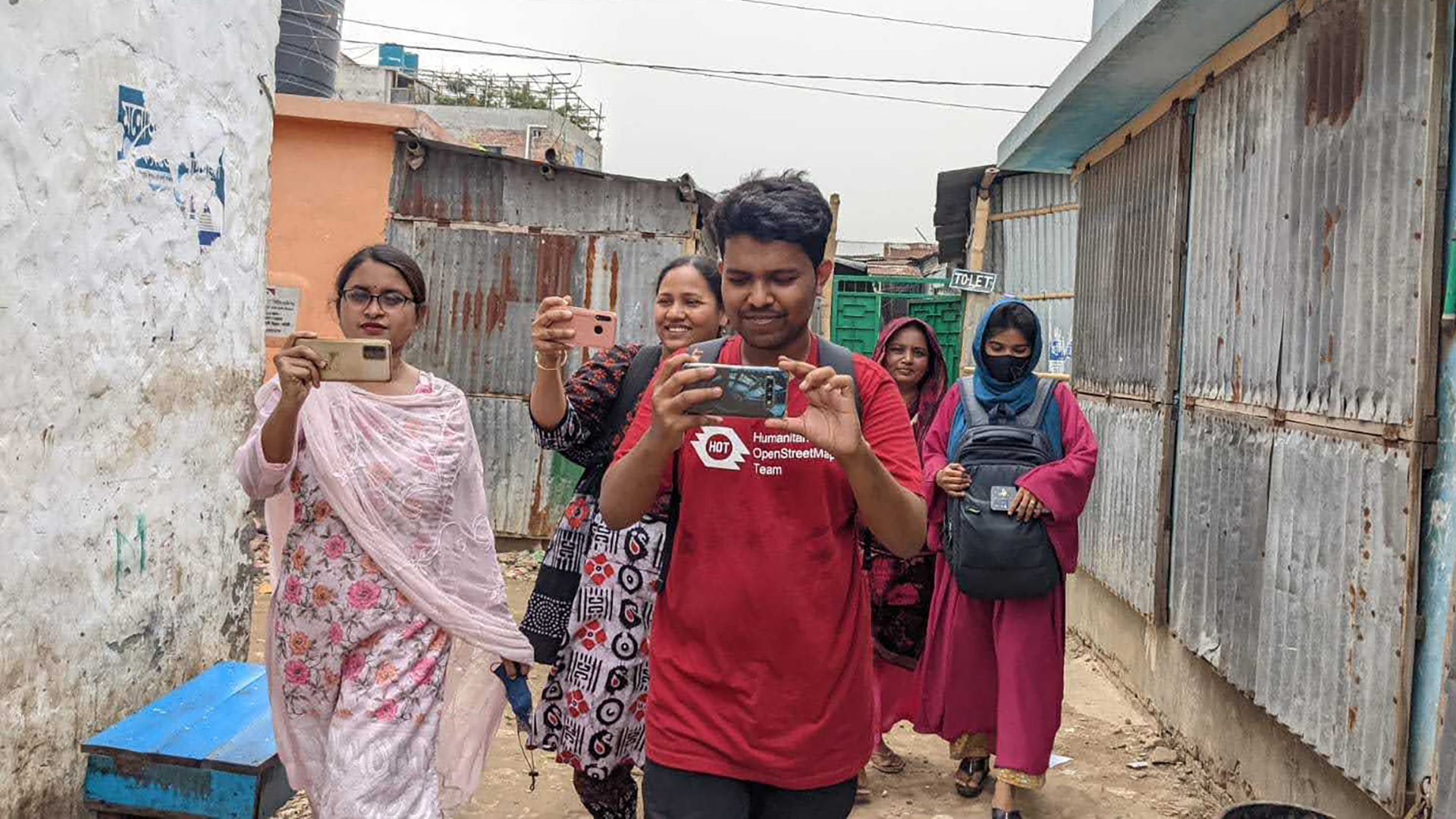News — 27 July, 2025
Mapping for Equity: Voices from Dhaka’s Informal Settlements

Discover how community-led open mapping is transforming lives in Dhaka’s informal settlements. Brazil Singh shares powerful insights from the Dhaka Thrive Project, where data becomes a tool for justice, resilience, and local enhancement.
When I first started working with open mapping, I had no idea how much data could affect the lives of people living in at-risk communities. As a mapper from Dhaka, I’ve always known how important it is to do something about our changing, growing capital city. Because of this, I see my work on the Dhaka Thrive Project as a mission, a privilege, and a duty, not just an experience.
A Revolution for the Informal Settlements of Dhaka
In March 2024, World Vision Bangladesh and the Open Mapping Hub-Asia-Pacific started collaborating on the Dhaka Thrive Project. For what reason is it used? to deal with the growing challenges in Dhaka’s slums, which are also known as informal settlements, that are caused by urbanization, climate change, and worries about public health.
In locations like Korail, Duaripara, and Millat Camp, thousands of refugees lack access to sanitary facilities, safe drinking water, and shelter. Planning interventions with accurate data is more important than ever because flooding, dengue outbreaks, and inadequate infrastructure are putting human life in danger. That is what this project provides.
Why This Project Matters to Me
The idea behind the Dhaka Thrive Project is very attractive to me as someone who is very involved with OpenStreetMap (OSM) and positive about community-driven mapping in Bangladesh. Using mapping as a tool for fairness and change, raising voices, and empowering the marginalized are more important than simply collecting data.
On March 21, 2024, I received an invitation from the Open Mapping Hub Asia-Pacific and the amazing Mikko Tamura, Community Manager at HOT. I was invited to coordinate the Open Mapping Guru field visit and data collection in Dhaka, and I was absolutely thrilled. It was not just an opportunity but a milestone for me as a mapper, trainer, and community builder.
We were joined by inspiring international guests like Can Unen, Honey Grace Fombuena, and Harry Mahardhika Machmud from HOT. Along with other Open Mapping Gurus and the local team from World Vision Bangladesh, we prepared to map two vulnerable areas in Mirpur: Duaripara and Millat Camp.
I led the Mapillary team, working closely with Harry, while others led ODK data collection and Field Papers. Before heading out, I trained our volunteers on how to use Mapillary and what types of data to collect, from street-level imagery to capturing risks like open drains, water points, and electrical hazards.
In just 1.5 hours of field time, our Mapillary teams split into subgroups, collecting data both inside the slums and around the slums. We gathered powerful insights and captured real challenges visually, something that paper or conversation alone couldn’t achieve.
Brazil Singh Collecting Data Using Mapillary
After the field visit, we returned to the office and held open discussions. We shared what we saw, what went well, and where we could improve. We also spoke with local residents to better understand their needs, especially around water, waste management, and health hazards.
In total, we successfully mapped 932 POIs across 41 settlements. What made this achievement even more powerful was that it wasn’t done from afar. It was accomplished hand-in-hand with the community. We trained local volunteers on how to safely collect data and capture images using open-source tools, helping them become data stewards of their own neighborhoods.
This practical experience not only confirmed the value of open mapping, but it also brought back to mind my original inspiration: to make a genuine, visible difference for those who are far too frequently ignored on maps.
From Field to Dashboard: A Surprising Moment
After completing the data collection in Mirpur, I thought our main task was done, that we had contributed valuable data, and that was the end of it. But I was in for a wonderful surprise.
Shortly after, I saw the uMap dashboard built by Honey Grace Fombuena, using the exact data we had collected in the field. Seeing our fieldwork transformed into a clean, interactive map, with icons showing schools, clinics, dengue hotspots, and more, was honestly magical.
For me, it was a powerful realization: data doesn’t just sit in a spreadsheet. When visualized and shared through open platforms like uMap, it becomes actionable, accessible, and impactful. It becomes something that communities, NGOs, and decision-makers can actually use to create change.
I’m thrilled to share that I’m now working on a current project, OSM Academy, supported by the Open Mapping Hub Asia-Pacific, as part of the CRF Fellowship.
OSM Academy is an open platform that aims to enhanceempower youth and volunteers in Dhaka’s slums to tackle climate vulnerability (especially heatwaves) by developing localized tools and training materials and providing capacity-building training through a dedicated website. As we build this academy, we can integrate the uMap dashboard developed during Dhaka Thrive to support real-time community needs.
For example:
-
Showing nearby hospitals and clinics during emergencies.
-
Highlighting clean drinking water sources during floods or water shortages.
-
Identifying dengue hotspots, open drains, or flood-prone areas for awareness and action.
Mapping is a Form of Justice
When we talk about urban development, we often think of big buildings, highways, and smart cities. But real development starts in places like slums, where millions live in vulnerability. And to bring justice to those communities, we must see them clearly, understand their needs, and include them in the process.
That’s what Dhaka Thrive is doing. It’s not about mapping for the sake of maps, it’s about mapping for equity, dignity, and survival.
And that’s why I’m proud to be part of it.
Brazil Singh,
Regional Ambassador | Youthmappers
Communication Working Group | OSMF
Open Mapping Guru, AP Hub | Open Mapping Hub
WordPress Web Developer (Freelancer) | Fiverr
*Voting Member | Humanitarian OpenStreetMap Team (HOT)

